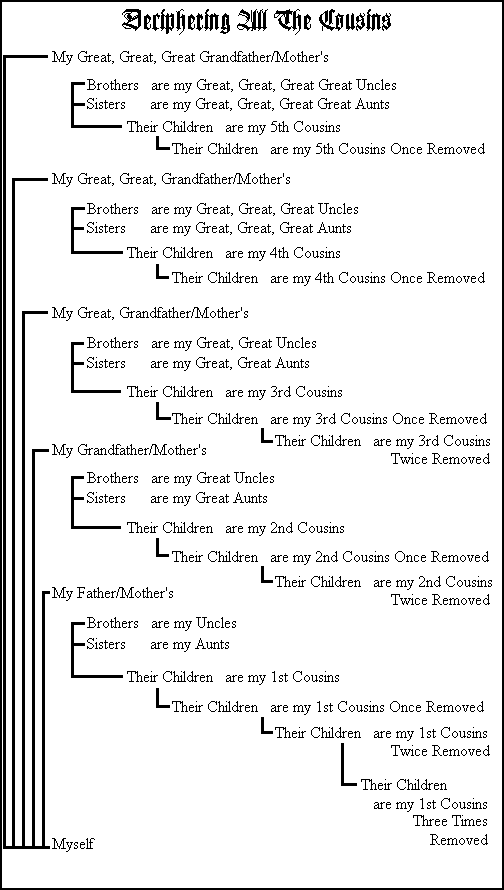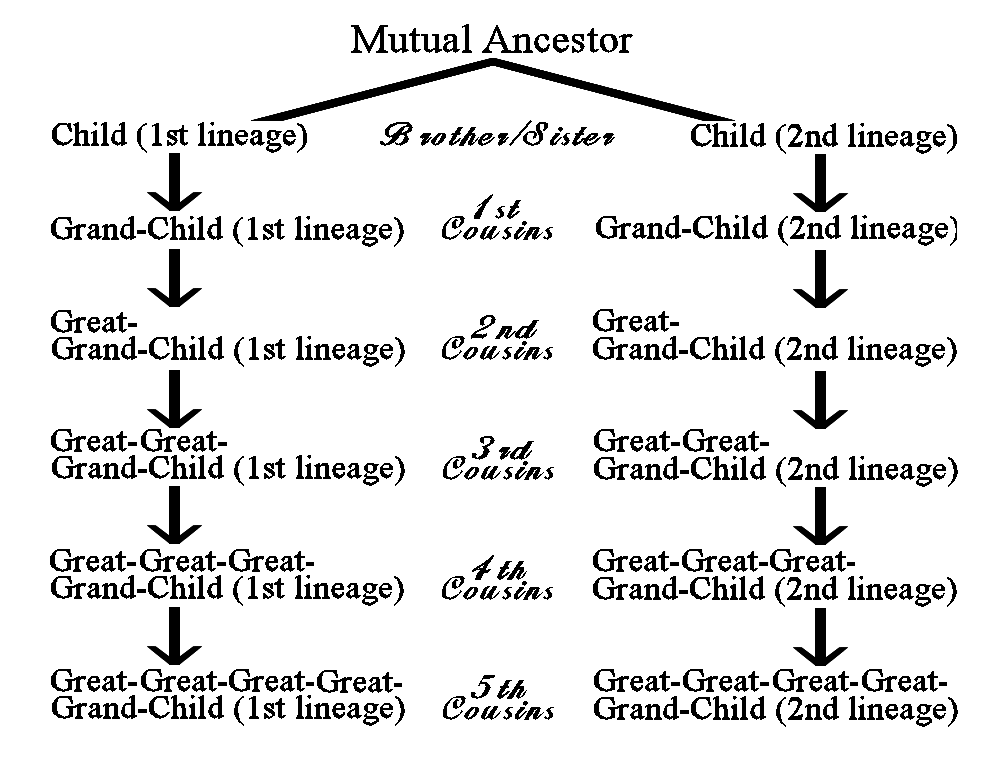

![]() Many people who are interested in genealogy accumulate names and dates about all the people they are related to, but they have trouble figuring out what relationship they are to those other people.
Many people who are interested in genealogy accumulate names and dates about all the people they are related to, but they have trouble figuring out what relationship they are to those other people.
![]() You can use the chart below to figure out your relationship to another person in your family tree.
You can use the chart below to figure out your relationship to another person in your family tree.

![]() Look at the chart above. It should be easy to understand the fact that your father's brother is your uncle. And it should also be easy to understand that your uncle's son or daughter is your first cousin. So, to go one step further, if your first cousin (e.g. your uncle's daughter) has a child, that child will be your first cousin, once removed, because that child will be one generation removed from the generational level between you and your direct first cousin. To go one step further, if one of your "first cousins, once removed" has a child, that child will be just one more generation removed from your common generation level (i.e. your uncle's daughter, or first cousin), and therefore would be considered your first cousin, twice removed.
Look at the chart above. It should be easy to understand the fact that your father's brother is your uncle. And it should also be easy to understand that your uncle's son or daughter is your first cousin. So, to go one step further, if your first cousin (e.g. your uncle's daughter) has a child, that child will be your first cousin, once removed, because that child will be one generation removed from the generational level between you and your direct first cousin. To go one step further, if one of your "first cousins, once removed" has a child, that child will be just one more generation removed from your common generation level (i.e. your uncle's daughter, or first cousin), and therefore would be considered your first cousin, twice removed.
![]() One basic point to remember is that two individuals who are the same number of generations away from the same ancestor are direct cousins.
One basic point to remember is that two individuals who are the same number of generations away from the same ancestor are direct cousins.
![]() In other words, if you and another person are both two generations away from the same man (e.g. your maternal grandfather), you are second cousins to each other. If you and another person are both three generations away from the same woman (e.g. your paternal great~grandmother), you are third cousins to each other.
In other words, if you and another person are both two generations away from the same man (e.g. your maternal grandfather), you are second cousins to each other. If you and another person are both three generations away from the same woman (e.g. your paternal great~grandmother), you are third cousins to each other.
![]() Two individuals who are not the same number of generations away from the same ancestor are indirect cousins (i.e. one or the other will be "removed"). In the situation where you and another person are not the same number of generations away from the same ancestor, you first need to find a common "direct" cousin, and then figure the number of generations that you (or the other person) are removed from that common "direct" cousin.
Two individuals who are not the same number of generations away from the same ancestor are indirect cousins (i.e. one or the other will be "removed"). In the situation where you and another person are not the same number of generations away from the same ancestor, you first need to find a common "direct" cousin, and then figure the number of generations that you (or the other person) are removed from that common "direct" cousin.
![]() In other words, if you and another person are not direct cousins on any particular generation, you can't locate an ancestor who is the same number of generations away from both of you. If you determine that you and the father of the other person are direct third cousins, then the other person is your third cousin, one generation (i.e. once) removed.
In other words, if you and another person are not direct cousins on any particular generation, you can't locate an ancestor who is the same number of generations away from both of you. If you determine that you and the father of the other person are direct third cousins, then the other person is your third cousin, one generation (i.e. once) removed.

![]() Now, to determine the relationship between any two descendants of the same ancestor, refer to the table below. The children of the mutual ancestor are brothers and sisters of each other. The children of the brothers and sisters (the mutual ancestor's grandchildren) are 1st cousins of each other and so forth.
Now, to determine the relationship between any two descendants of the same ancestor, refer to the table below. The children of the mutual ancestor are brothers and sisters of each other. The children of the brothers and sisters (the mutual ancestor's grandchildren) are 1st cousins of each other and so forth.
![]() As noted above, the relationship of any direct cousin to the children of the corresponding cousin are noted as one time (i.e. once) removed. Children of those children (or the direct cousin's grandchildren) are notes as two times (i.e. twice) removed.
As noted above, the relationship of any direct cousin to the children of the corresponding cousin are noted as one time (i.e. once) removed. Children of those children (or the direct cousin's grandchildren) are notes as two times (i.e. twice) removed.

